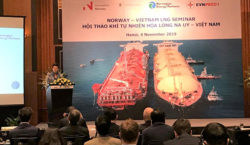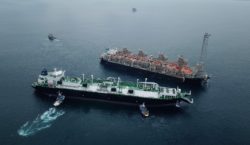
88 representatives from the Maritime industry, government and research were present as Innovation Norway held the Norway-Singapore LNG bunkering forum at the Tanglin Club in Singapore on Monday 24 April 2017. Norway has 53 years of experience with LNG and were in Singapore to share their experiences, and in hope of building more optimism regarding LNG as a maritime fuel in Singapore and Asia.
LNG stands for liquefied natural gas and is a green solution that can be used as fuel instead of for example coal or oil. By being liquefied, it makes the natural gas much easier to transport over longer distances and is therefore an interesting solutions for shipping companies who want to reduce contamination.

State Secretary Dilek Ayhan, Norwegian Ministry of Trade, Fisheries and Industry, gave the opening keynote speech mentioning a history of strong bilateral relations between Singapore and Norway and talked about her hopes for future cooperation in the maritime area between the two countries.
“In a rapidly changing global economy, characterized by sluggish economic growth, increasing demand for energy and a climate in crisis, LNG and green shipping represent viable solutions for a better future. We have a shared interest in healthy oceans, and in further reducing the ecological footprint of maritime transport,” said Ayhan. “In order to succeed, we must collaborate, both within and across borders. Therefore I am pleased to see so many representatives from Singapore and Norway here today.”
“The potential of green shipping and use of LNG is at the core of this forum today, and I truly believe we can mutually benefit from close cooperation.”

Per Christer Lund, Science and Technology Counselor at Innovation Norway, the organizer behind the forum, reveals that at first he only expected to have a closed workshop for 20 to 30 people, but because the interest was so big it turned into a forum with 88 people.
Innovation Norway hopes the forum can help connect the Norwegian experiences to the Singaporean development of the LNG infrastructure, and believe that transfer of knowledge and experience will help exhilarate the deployment of energy in Singapore.
“We have been doing this for several years and I think Singapore appreciates the hands-on experience,” says Lund.
Lasse Karlsen, Technical Director at Norwegian Maritime Authority, followed Ayhan with a presentation on Norway’s experience on bunkering and operation of LNG fueled ships.
LNG is a clean fuel, but also has the potential to be economically competitive compared to heavy fuel oil, according to Karlsen’s presentation. He also mentioned that LNG is a fuel which can be used in large quantities as the predicted amount of it is expected to be able to last for several hundred years.

As one of the biggest concerns of LNG is safety, Karlsen also used his presentation to lay out Norway’s experience with it and talk about safety and safety precautions when working with LNG.
Shipping of LNG goes back 53 years and in that time there has been no fatalities related to the 179 accidents that has happened on LNG ships. Lasse Karlsen calls that an excellent safety record. Furthermore, he laid out all the accidents caused in connection with LNG, including ways to deal with it in order to avoid the same mistakes happening again.
Karlsen believes that when shipowners in the near future will have to look into new energy solutions, LNG is the best answer.
“With wind energy you will need to collect and store it in a way. Then you will need batteries. And if you use batteries for sailing long distances, you will need a lot of batteries,” says Karlsen. “Then you will think of other gasses. Hydrogen you can get from wind turbines, but it is much more dangerous than LNG, so we believe the cost will be very high.”
Per Christer Lund was very pleased with Karlsen’s presentation.
“I hope to achieve some optimism in the Singaporean community, that it is fully possible to develop a LNG infrastructure and to address the worries that are connected to safety and security,” he said.

James Seow from Maritime and Port Authorities of Singapore talked about Singapore’s current status of LNG bunkering developments. Singapore is as the leading maritime city in the world working on new energy solutions and sees LNG bunkering as one of the longer term solutions for the future. They are currently working towards becoming bunker-ready in 2020 and has started their pilot program in 2017.
Afterwards there were presentations discussing safety, risks and the best practise of LNG bunkering, presentations on the newest developments and three speakers who shared their hands on experience with LNG bunkering.

The day ended with a panel discussion, reflecting over the many speeches and presentation at the forum. The panel agreed that it was positive to see such progress in LNG, but they also addressed the safety questions.
“You don’t see it leaking like oil, but it can still be detected. There are differences and you have to be aware of it. You have to train and educate people for it,” said Lasse Karlsen.





